Acne Treatment Selector
Your Recommended Treatment
Why This Works For You
Treatment Comparison
| Ingredient | Primary Mechanism | Typical Strength | Application Frequency | Key Side Effects | Best For |
|---|---|---|---|---|---|
| Benzoyl Peroxide | Antibacterial + mild keratolysis | 2.5%–10% | Once or twice daily | Dryness, redness, bleaching of fabrics | Moderate-to-severe inflammatory acne |
| Salicylic Acid | Oil-soluble exfoliation | 0.5%–2% | Once daily | Mild irritation, occasional stinging | Oily, blackhead-prone skin |
| Glycolic Acid (AHA) | Surface exfoliation | 5%–10% (OTC) | 2–3 times weekly | Sun sensitivity, tingling | Post-acne marks, uneven texture |
| Adapalene (Retinoid) | Cell turnover normalization | 0.1%–0.3% | Once nightly | Dryness, peeling, initial flare-up | Combination acne, prevention |
| Tea Tree Oil | Antimicrobial terpinen-4-ol | 5%–10% (diluted) | Once daily | Allergic dermatitis, odor | Mild, occasional breakouts |
| Sulfur | Keratolytic drying | 3%–10% | Once daily | Dryness, strong smell | Sensitive skin, early-stage lesions |
Trying to clear up acne feels like a never‑ending experiment. You buy a product with benzoyl peroxide, hope for clear skin, and end up with dryness or irritation. Before you toss the tube away, it helps to see how it stacks up against other go‑to acne fighters. This guide breaks down benzoyl peroxide, its main rivals, and how to pick the right one for your skin type, budget, and tolerance.
Quick Takeaways
- Benzoyl peroxide kills acne‑causing bacteria and clears pores but can be drying.
- Salicylic acid exfoliates and unclogs pores, ideal for oily skin.
- Alpha hydroxy acids (AHAs) like glycolic acid smooth texture and fade post‑acne marks.
- Retinoids reduce cell turnover and prevent new lesions; prescription strength works fastest.
- Natural options such as tea tree oil and sulfur are milder but may need higher concentrations.
What Is Benzoyl Peroxide?
Benzoyl peroxide is a synthetic antimicrobial compound commonly used in over‑the‑counter acne creams and gels. First introduced in the 1930s for treating bacterial infections, it became a dermatology staple in the 1970s when researchers discovered its ability to eradicate Propionibacterium acnes (now Cutibacterium acnes) and reduce inflammation.
How Benzoyl Peroxide Works
The molecule releases oxygen into the hair follicle, creating an environment where the acne‑causing bacteria cannot survive. At the same time, it gently peels the top layer of skin, helping clogged pores open up. Typical concentrations range from 2.5% to 10%; higher percentages increase antibacterial power but also raise the risk of redness, peeling, and sensitivity.
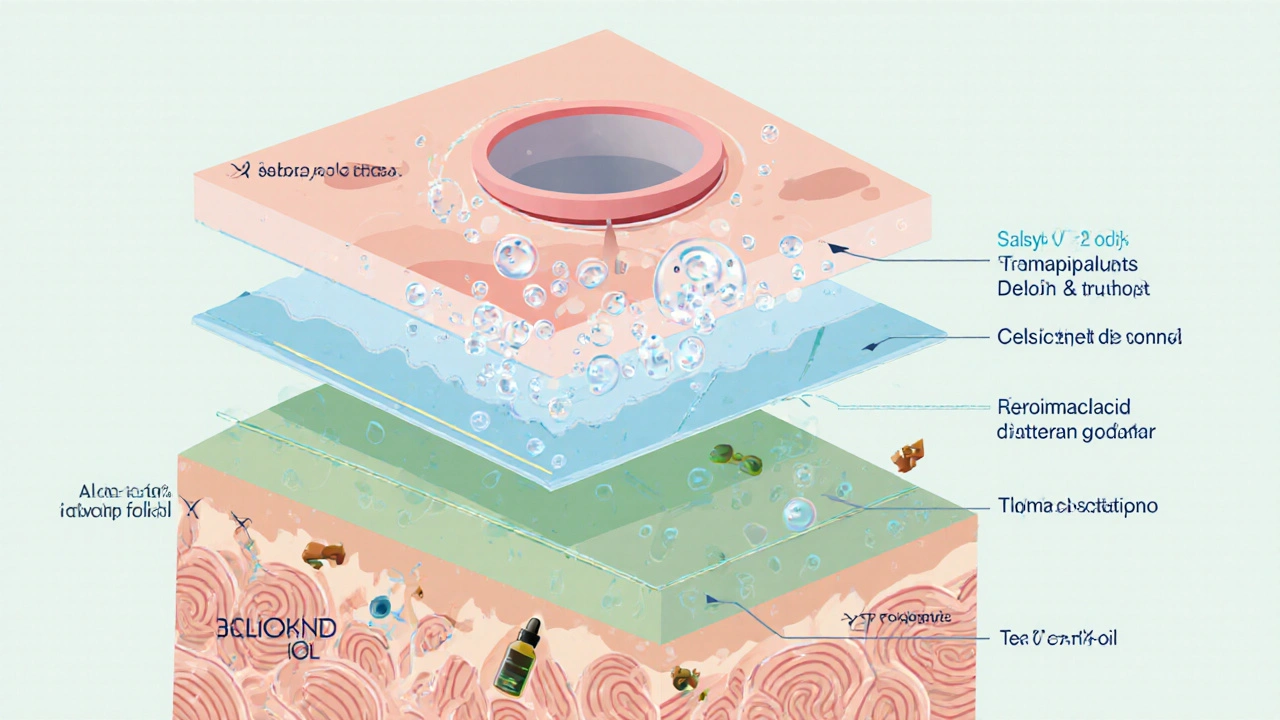
Big‑Name Alternatives
Below are the most widely recommended alternatives, each with its own mechanism and ideal use case.
Salicylic Acid
Salicylic acid is a beta‑hydroxy acid (BHA) derived from willow bark. It penetrates oily pores, loosening the waxy sebum that traps dead skin cells. Concentrations of 0.5%-2% are common in leave‑on products, while 3%-5% can be found in spot‑treatment gels.
Alpha Hydroxy Acids (AHAs)
Glycolic acid, the most popular AHA, is a water‑soluble acid that works on the surface of the skin. By dissolving the bonds between dead cells, it smooths texture and fades post‑acne hyperpigmentation. Typical over‑the‑counter formulas contain 5%-10% glycolic acid; professional peels can exceed 30%.
Retinoids
Adapalene (a third‑generation retinoid) is available OTC at 0.1% and by prescription up to 0.3%. It normalizes skin cell turnover, prevents clogged pores, and reduces inflammation. Retinoids are the only acne ingredient that works on both existing lesions and future breakouts.
Tea Tree Oil
Tea tree oil is an essential oil extracted from Melaleuca alternifolia. Its terpinen-4-ol component offers antimicrobial properties comparable to low‑dose benzoyl peroxide, but the scent and potential for allergic reactions limit its use to 5%-10% solutions.
Sulfur
Sulfur has been used since ancient times to dry out pimples. Modern formulations combine it with zinc or salicylic acid, delivering a mild keratolytic effect without the bleaching side effects of benzoyl peroxide.
Side‑by‑Side Comparison
| Ingredient | Primary Mechanism | Typical Strength | Application Frequency | Key Side Effects | Best For |
|---|---|---|---|---|---|
| Benzoyl Peroxide | Antibacterial + mild keratolysis | 2.5%-10% | Once or twice daily | Dryness, redness, bleaching of fabrics | Moderate‑to‑severe inflammatory acne |
| Salicylic Acid | Oil‑soluble exfoliation | 0.5%-2% | Once daily | Mild irritation, occasional stinging | Oily, blackhead‑prone skin |
| Glycolic Acid (AHA) | Surface exfoliation | 5%-10% (OTC) | 2-3 times weekly | Sun sensitivity, tingling | Post‑acne marks, uneven texture |
| Adapalene (Retinoid) | Cell turnover normalization | 0.1%-0.3% | Once nightly | Dryness, peeling, initial flare‑up | Combination acne, prevention |
| Tea Tree Oil | Antimicrobial terpinen‑4‑ol | 5%-10% (diluted) | Once daily | Allergic dermatitis, odor | Mild, occasional breakouts |
| Sulfur | Keratolytic drying | 3%-10% | Once daily | Dryness, strong smell | Sensitive skin, early‑stage lesions |
How to Choose the Right Acne Fighter
Think of acne treatment like picking a workout routine: you need to match intensity with your current fitness (skin) level. Use the following decision matrix.
- Assess severity. If you have deep, inflamed nodules, benzoyl peroxide or a prescription retinoid is usually the fastest route.
- Identify skin type. Oily, acne‑prone skin often benefits from salicylic acid’s oil‑soluble action, while dry or sensitive skin may tolerate only low‑percentage benzoyl peroxide or sulfur.
- Consider tolerance for side effects. If bleaching clothes is a dealbreaker, steer clear of benzoyl peroxide. If you can handle occasional dryness, a retinoid’s long‑term benefits might outweigh the short‑term peeling.
- Check lifestyle factors. Sun exposure requires AHAs or retinoids paired with sunscreen; night‑time routines suit retinoids better than daytime benzoyl peroxide.
- Budget and accessibility. Over‑the‑counter benzoyl peroxide and salicylic acid are cheap and easy to find, while prescription retinoids need a dermatologist visit.
Mixing ingredients can be powerful-but also risky. For example, applying benzoyl peroxide and a retinoid together often causes severe irritation. Space them out (e.g., peroxide in the morning, retinoid at night) and moisturize heavily.
Tips for Using Benzoyl Peroxide Effectively
- Start with the lowest concentration (2.5%) and gradually increase if your skin tolerates it. \n
- Apply a thin layer to clean, dry skin; wait 5‑10 minutes before adding moisturizers.
- Use a non‑comedogenic moisturizer containing ceramides or hyaluronic acid to counteract dryness.
- Wear sunscreen daily-benzoyl peroxide can make you more photosensitive.
- Store the product in a cool, dark place; exposure to light can degrade its potency.
Common Pitfalls and How to Avoid Them
Even seasoned acne‑battlers stumble into these traps.
- Over‑application. More isn’t better; a pea‑size amount per affected area is sufficient.
- Skipping moisturizer. Without a barrier, the skin barrier breaks down, leading to rebound oil production.
- Combining strong actives. Pairing benzoyl peroxide with vitamin C serums can neutralize both ingredients.
- Ignoring patch testing. Always test a new product on the jawline for 48hours before full‑face use.
- Changing products too quickly. Give each new ingredient at least 4‑6 weeks to show results before swapping.
Frequently Asked Questions
Can I use benzoyl peroxide and salicylic acid together?
Yes, but only if you keep the concentrations low and apply them at different times (e.g., peroxide in the morning, salicylic acid at night). This reduces the risk of excessive irritation.
How long does it take to see results with benzoyl peroxide?
Most users notice a reduction in active breakouts within 3‑5 days, but full clearance can take 4‑6 weeks of consistent use.
Is benzoyl peroxide safe for pregnant women?
Studies show low‑dose benzoyl peroxide (up to 5%) is generally considered safe during pregnancy, but you should always consult your obstetrician before starting any acne medication.
Why does my pillowcase bleach after using benzoyl peroxide?
Benzoyl peroxide releases oxygen radicals that can oxidize fabrics. Switch to white or light‑colored bedding, or protect your pillow with a dark, breathable cover.
Can I replace benzoyl peroxide with tea tree oil for mild acne?
Tea tree oil works for mild, occasional breakouts, but it’s less potent against inflammatory acne. If you have moderate acne, consider a low‑dose benzoyl peroxide or a combination approach.
Bottom line: there’s no one‑size‑fits‑all acne solution. Benzoyl peroxide remains the heavyweight champion for fast‑acting bacterial kill, yet alternatives like salicylic acid, glycolic acid, adapalene, tea tree oil, and sulfur each fill specific gaps. By matching the ingredient to your skin’s needs, you’ll avoid endless trial‑and‑error and get closer to clear, calm skin.

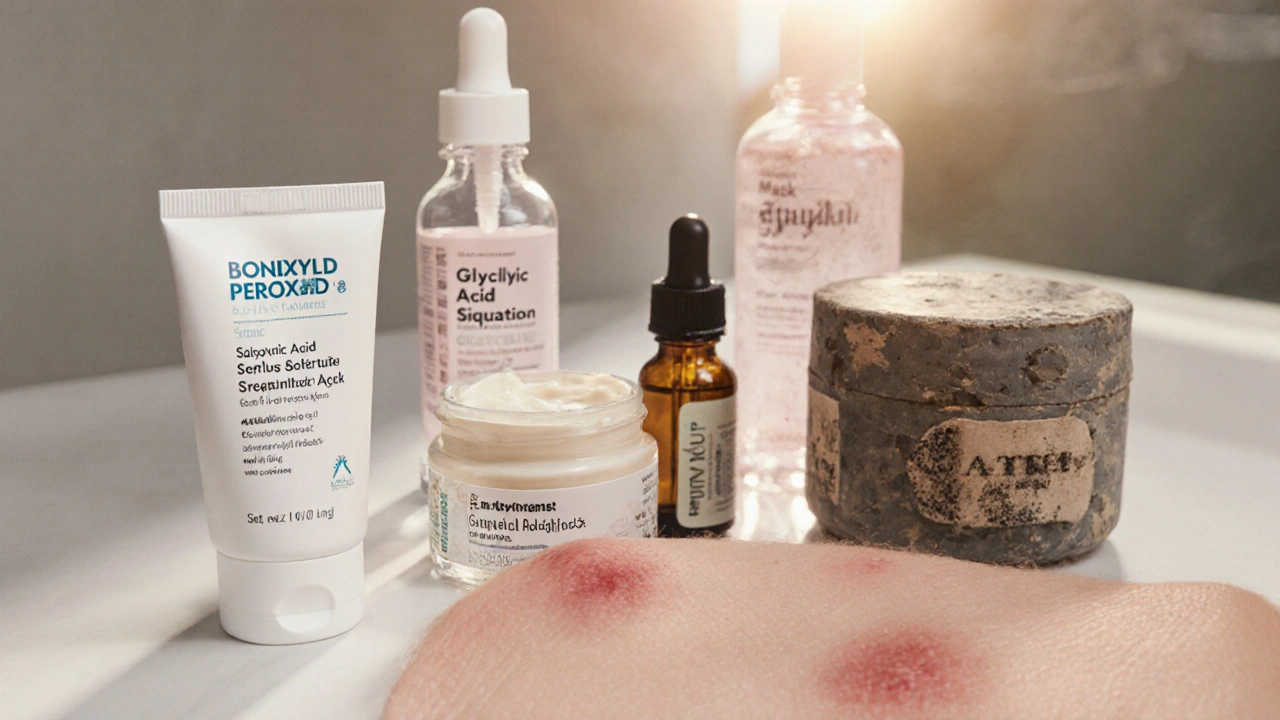

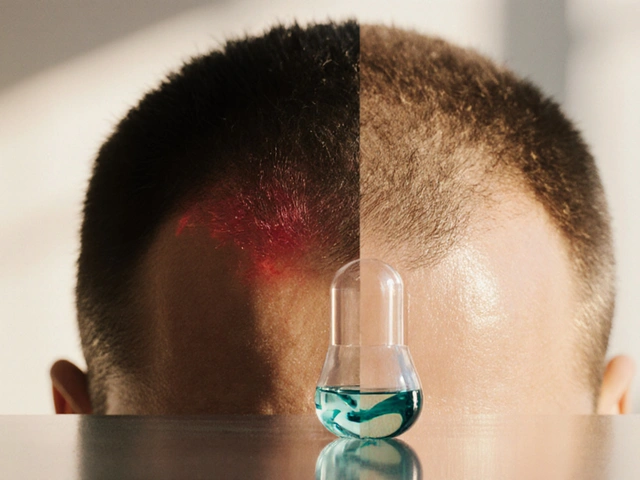
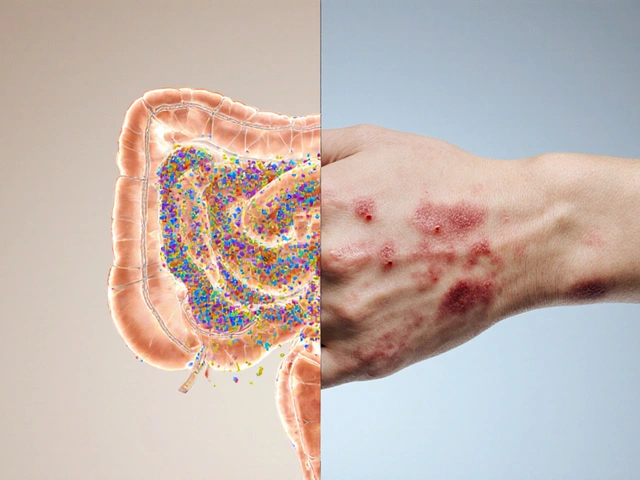

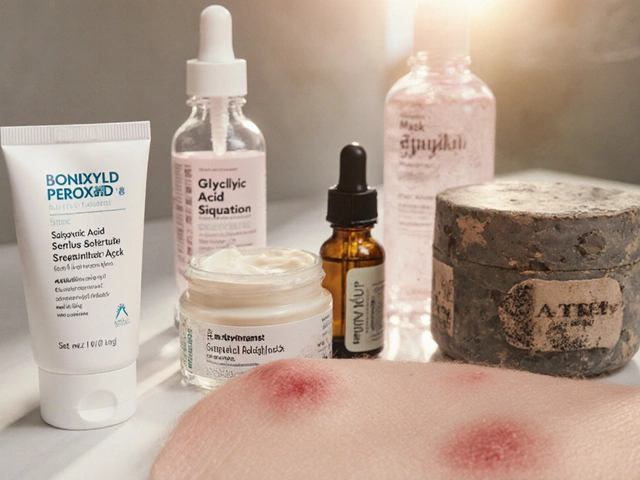
Holly Hayes
October 6, 2025 AT 16:14If you cant handle a dab of benzoyl peroxide, just use talc.
Matthew Shapiro
October 14, 2025 AT 08:44The guide does a solid job laying out the pros and cons of each acne-fighting ingredient. Benzoyl peroxide is highlighted for its antibacterial punch, while salicylic acid shines on oily skin. Glycolic acid tackles texture, and adapalene offers the most comprehensive cell turnover benefits. Natural options like tea tree oil and sulfur are useful for mild, occasional breakouts. Overall, the decision matrix helps match treatment intensity to skin type, tolerance, and budget.
Julia Phillips
October 22, 2025 AT 01:14Reading this felt like a cinematic journey through the battlefield of breakouts. I could almost hear the battle cries of bacteria being vanquished by benzoyl peroxide, while gentle exfoliators like salicylic acid tiptoe across oily pores. The empathy woven into the side‑effect table shows real care for those of us who have felt the sting of dryness. For anyone whose confidence has been bruised by acne, this guide offers a hopeful script-pick the hero that fits your skin’s story and watch the drama fade.
Richa Punyani
October 29, 2025 AT 16:44Esteemed readers, let us embark upon a disciplined quest toward clearer skin! In the realm of dermatologic excellence, benzoyl peroxide stands as a steadfast knight, yet our allies-salicylic acid, glycolic acid, and adapalene-bring their own noble virtues. Choose your champion wisely based on severity, type, and patience. May your regimen be diligent, your moisturiser generous, and your confidence ever‑rising.
Bhupendra Darji
November 6, 2025 AT 09:14I totally agree with the layout-mixing ingredients can be powerful but we need to be careful. If you’re using benzoyl peroxide in the morning, consider applying adapalene at night to avoid irritation. Also, a good moisturizer with ceramides can keep the barrier intact while you’re treating. Happy to collaborate if anyone wants to share their own combos.
Robert Keter
November 14, 2025 AT 01:44When it comes to orchestrating a multi‑step acne regimen, timing is everything, and this cannot be overstated. First, begin with a clean, dry canvas; any residual water will dilute the potency of benzoyl peroxide, rendering it less effective. Apply a pea‑size amount of a 2.5 % benzoyl peroxide gel in the morning, allowing it to fully absorb for at least five minutes before layering any sunscreen or moisturizer. This waiting period ensures the active ingredient penetrates the follicular wall without being neutralized. In the evening, introduce adapalene at a concentration of 0.1 % once nightly, but only after the skin has rested from the day’s exposure, as the retinoid’s mechanism of normalising keratinocyte turnover thrives in low‑light conditions. Should you notice excessive dryness, supplement with a non‑comedogenic moisturizer enriched with hyaluronic acid and ceramides; these ingredients restore the lipid barrier and mitigate the peeling that often follows retinoid initiation. Moreover, it is prudent to cycle the two actives rather than use them back‑to‑back; for instance, reserve benzoyl peroxide for the first half of the week and adapalene for the latter half, thereby reducing the risk of cumulative irritation. If you opt for a daily combination, separate application times-peroxide in the morning, retinoid at night-are mandatory. Additional supportive measures include a broad‑spectrum sunscreen of SPF 30 or higher, as both agents can increase photosensitivity. Finally, patience is the ultimate virtue; clinical improvement typically emerges after four to six weeks of consistent use, with most users observing a noticeable decline in inflammatory lesions by the third week. Remember, the skin’s microbiome is a delicate ecosystem, and abrupt over‑exposure to aggressive actives can provoke rebound oil production, undoing the hard‑earned gains. Therefore, steady, measured progression is the key to lasting clarity.
Rory Martin
November 21, 2025 AT 18:14It is worth noting that the mainstream dermatology narrative conveniently omits the fact that certain large pharmaceutical conglomerates have long‑standing agreements with major retailers to push benzoyl peroxide as the universal solution. This strategic partnership ensures a steady stream of revenue while marginalising alternative botanicals that could actually restore skin health without the harsh oxidative stress. The subtle laundering of public perception through glossy advertisements is a classic example of controlled opposition. Therefore, while the guide appears balanced, be aware that the data may be curated to favour the most profitable actives.
Maddie Wagner
November 29, 2025 AT 10:44Hey fellow skin‑warriors! If you’re feeling overwhelmed by the sheer number of options, remember that consistency beats complexity. Start with a low‑strength benzoyl peroxide once a day, pair it with a gentle cleanser, and never skip moisturizer. Celebrate the tiny victories – even a single breakout fewer is progress. You’ve got this, and we’re all cheering you on!
Boston Farm to School
December 7, 2025 AT 03:14Interesting breakdown, I appreciate the thoroughness :) I tend to stick with salicylic acid for its oil‑soluble action; it works well with my routine. 👍
Emily Collier
December 14, 2025 AT 19:44The explanation regarding the oxidative mechanism of benzoyl peroxide is scientifically accurate, and the recommendation to incorporate a ceramide‑based moisturizer aligns with current evidence on barrier repair. This balanced approach should minimize adverse effects while maximizing therapeutic benefit.
Catherine Zeigler
December 22, 2025 AT 12:14Choosing the right acne fighter is akin to assembling a balanced orchestra; each instrument must play its part in harmony. Benzoyl peroxide delivers the powerful percussion of antibacterial action, yet without the gentle strings of a soothing moisturizer, the composition can become harsh. Salicylic acid, with its oil‑soluble melody, penetrates deep into pores like a well‑tuned violin, while glycolic acid provides the subtle woodwind texture that smooths surface irregularities. Retinoids, the brass section, bring a bold, transformative crescendo that reshapes cellular turnover. Natural options such as tea tree oil and sulfur add unique tonal colors, though they may require a higher volume to be heard over the louder agents. The key is to arrange these elements thoughtfully: start with a calm prelude of cleansing, introduce the main themes gradually, and always conclude with a restorative coda of hydration. When the ensemble is conducted with patience and precision, the resulting symphony is clear, radiant skin.